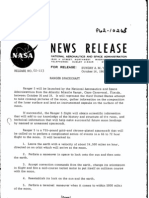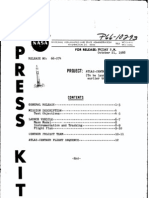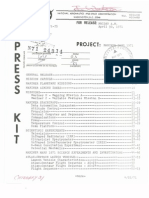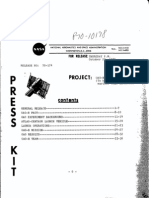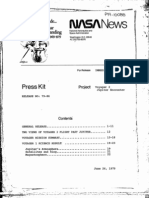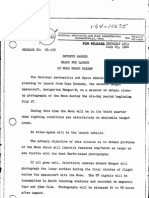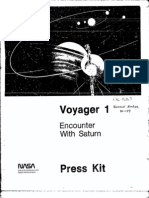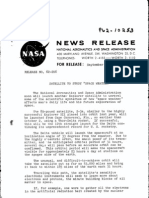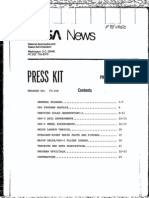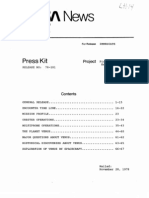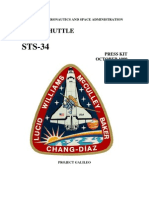NASA Facts Mariner IV
NASA Facts Mariner IV
Uploaded by
Bob AndrepontCopyright:
Available Formats
NASA Facts Mariner IV
NASA Facts Mariner IV
Uploaded by
Bob AndrepontCopyright
Available Formats
Share this document
Did you find this document useful?
Is this content inappropriate?
Copyright:
Available Formats
NASA Facts Mariner IV
NASA Facts Mariner IV
Uploaded by
Bob AndrepontCopyright:
Available Formats
Page 1
NASA
FACTS
Vol. II, No.9
An Educational Services Publication of the National Aeronautics and Space Administration
MARINER IV
Mariner IV spacecraft.
The United States has launched an unmanned spacecraft in the first American experiment to explore space farther from the sun than earth's orbit. The spacecraft, called Mariner IV, is equipped to report on space phenomena that it
encounters and, if all goes well, to provide mankind with the first close look at Mars. The experiment also provides engineering experience in operation of spacecraft during prolonged flights away from the sun.
-j
Two views of the Mariner IV spacecraft, showing locations of principal parts.
Page 2
SCIENTIFIC INVESTIGATIONS
Mariner is equipped to carry out a broad ange of investigations in interplanetary space and near Mars. The investigations include:
1. Ionization Chamber-The Mariner IV ionization chamber is a five-inch diameter sphere filled with argon gas. It is designed to measure the intensity of high-energy radiation, particularly cosmic rays. When cosmic ray particles (nuclei of hydrogen or helium atoms, nuclei of atoms heavier than hydrogen or helium, or electrons-originating principally outside of the solar system) penetrate the sphere, they strip electrons from the argon gas atoms, creating a trail of argon ions. The degree of ionization yields a measurement of the energy of the particles. A Geiger-Mueller Tube associated with the chamber furnishes a count of particles. Together, the instruments provide information on the density and energy levels of cosmic rays.
2. Trapped Radiation Detector-The principal purpose of this instrument is to report the existence, if any, of a radiation belt around Mars similar to the Van Allen Radiation Region around the earth. The Van Allen Region consists of
tomic particles (chiefly electrons and protons) apped in the lines of force of earth's magnetic field. The detector also reports on radiation in interplanetary space.
3. Cosmic Ray Telescope-This instrument analyzes in detail portions of the cosmic ray energy range covered by the ionization chamber (above). It also detects particles with lower energy. The instrument derives its name from the fact that its three detectors are arranged like the series of lenses in a telescope. The degree of a particle's penetration-i.e. through one,
LOW-GAIN OMNI-ANTENNA
ION CHAMBER
MAGNETOMETER
COSMIC DUST
PROPULSION ASSEMBLY
THERMAL CONTROL LOUVERS ~ SOLAR PRESSURE VANE
NASA FACTS Vol. II, No.9 two, or three detectors-yields information relc tive to its energy.
4. Magnetometer-This instrument provides information on the strength and direction of magnetic fields in interplanetary space. It is also designed to determine the existence and nature of a magnetic field, if any, around Mars. Mariner II reported that magnetic fields were nearly always present in interplanetary space.
5. Micrometeoroid Detector-The micrometeoroid detector provides information on the distribution and momentum of tiny particles of matter in space. Mariner II reported relatively few micrometeoroids between earth and Venus. Mariner IV may encounter more meteoroids than Mariner II because it is flying toward the asteroids, one presumed source of micro meteoroids. In addition, Mariner IV passed through three meteoroid streams. In December 1964, the spacecraft flew through the Geminid and Ursid meteor streams. In March 1965, it passed through the Tuttle-Giacobini-Kresak stream. (The asteroids are a swarm of small celesti bodies in solar orbit, largely between the orbi of Mars and Jupiter. The three meteor streams are believed to be composed of particles once making up the nucleus of a comet. Both asteroids and comets have been said to be sources of meteoroids.)
6. Solar Plasma Probe-This instrument was included in Mariner IV's series of experiments to measure the density, velocity, temperature, and direction of the solar plasma between earth and Mars. Mariner II showed the plasma to be a predominant feature of the interplanetary space environment through which the spacecraft
CANOPUS SENSOR
NASA FACTS Vol. II, No.9
_w. The plasma significantly influenced cosmic rays and magnetic fields. Solar plasma is a
~ boiling off of the sun's atmosphere. It is a high velocity, high temperature electrified gas (hydrogen or helium).
7. Occultation Experiment-The trajectory, or flight path, of Mariner IV will carry the spacecraft behind Mars relative to earth. The manner in which Mariner's radio transmissions are distorted by the Martian atmosphere as the spacecraft flies behind the planet can indicate the atmosphere's density.
8. Television Camera-Mariner is expected to reach the vicinity of Mars at 9: 11 p.m. EDT, July 14, 1965, and draw as near as about 5,000 miles to the planet. While passing Mars, Mariner's television cameras will snap up to 22 black and white close-ups of the Martian surface for later telecast to earth. The strip of pictures is expected to show terrain features as much as 50 times smaller than those visible from earth.
SPACECRAFT DESCRIPTION
Mariner IV is basically an octagonally shaped structure 50 inches across. In and on this structure are attached the solar panels that generate electric power for spacecraft operation, communication equipment, experiments, a rocket engine for course changes, an orientation and stabilization system, and other components.
On earth, Mariner IV weighs 575 pounds. In space, with appendages deployed, Mariner spans 22 feet 7112 inches across its solar panels and solar vanes (see below) and extends 9112 feet from the base of the octagonal structure to the tip of the omni-antenna (an antenna that radiates radio signals in all directions).
Mariner IV has four solar panels as compared to the two with which Mariner" and the Ranger lunar spacecraft were equipped. This is intended to compensate for the decreasing intensity of sunlight with increasing distance from the sun. At the orbit of Mars, sunlight is only half as bright as at the orbit of earth.
The panels hold a total of 28,224 solar cells at convert sunlight to electric power. In addi-
ion, Mariner is equipped with a storage battery which provides power when the panels are not facing the sun (as during a course correction) and serves as a back-up during peak power de-
--_----------- - ---~-'-~-~
Aerodynamic shroud, which protected Mariner IV during launch through the atmosphere, is tested.
mands. The battery is recharged by the solar panels.
Solar pressure vanes attached to the ends of the solar panels balance out the faint pressure of the solar radiation by increasing or decreasing the area of the craft that faces the sun. They are an auxiliary attitude, or orientation, control system.
The primary attitude control system consists
MARINER III
Mariner III, launched toward Mars on November 5, 1964, failed when a new kind of shroud did not jettison as planned. The shroud covers a spacecraft and protects it from aerodynamic forces, such as the rush of air, created during launch.
Engineers designed, built, and tested another kind of shroud for Mariner IV. This shroud operated properly.
NASA FACTS Vol. II, No.9
Page 4
•
Solar panels of Mariner IV are attached.
of nitrogen gas jets linked to three gyroscopes, sun sensors, and a Canopus star sensor. The system is designed to keep the high-gain antenna (an antenna that focusses radio beams in a single direction, thereby providing maximum strength for receivers) pointed to earth, the solar panels facing the sun, and the television camera aimed at Mars when Mariner reaches the planet's vicinity. This attitude also provides a reference point from which the craft can be reoriented for midcourse guidance.
The sun sensor is a light-sensitive device that enerates an electric impulse when Mariner's solar panels are not receiving maximum sunlight.
The pulse activates gas jets, which turn the craft to the sun.
The Canopus sensor is a photomultiplier tube.
In such an instrument, light striking a grid knocks off electrons which in turn knock off more electrons in succeeding grids. This results in amplification of the light in the form of a measurable electric current.
The sensor is set to respond to light in the intensity range of the star Canopus. However, the lower end of this range grazes the brightness of other celestial objects. Moreover loss of the lock on Canopus could be caused by dust particles drifting between the sensor and Canopus
NASA FACTS Vol. II, No.9
and reflecting a flash of sunlight into the sensor. As a result, planners incorporated into Mariner IV a system by which it could be commanded from earth to search for Canopus.
Canopus is the second brightest star in the sky, exceeded in brilliance only by Sirius. It is about 100 light years or 600 trillion miles -from earth. It is a Southern Hemisphere star, visible no farther north than about 30 degrees latitude North (Florida).
The star was chosen as a reference point because it is located at about a 90 degree angle from the sun (another reference point) and is relatively isolated from other bright stars.
This is the first use of Canopus as a reference point. Mariner IV does not use earth as a reference point as did Mariner II and the Ranger lunar spacecraft. One reason is that the earth is in front of and shadowed by the sun relative to Mariner IV.
Ground personnel know when the Canopus lock is achieved by analyzing the radio signals into which the electric currents of the star sensor have been converted. The signals should match a predicted value for Canopus.
Altogether, Mariner IV is made up of 138,000 components. For Mariner to accomplish all of its goals, the components must remain functional for a minimum period of about nine months as the spacecraft hurtles approximately 350 million miles through the hostile environment of space.
FIRST JOURNEY FROM THE SUN
The Mariner experiment is the first in which American spacecraft have been launched in a flight away from the sun. As a result, the experiment provides the first experience in building and operating spacecraft for such missions.
Mariner IV began its approximately 350- million-mile journey when its Atlas-Agena booster launched it into a low earth orbit at a speed of about 18,000 miles per hour (mph). At the proper location in this orbit, the still attached Agena second stage ignited and propelled Mariner toward Mars at 25,598 mph.
This speed relative to earth is not maintained.
For example, at a distance of 122,000 miles, Mariner is pulling away from earth at a rate of about 8,000 mph. Although earth's gravity can never pull Mariner back to earth, its influ-
nce does slow Mariner down.
Page 5
Atlas-Agena booster launches Mariner IV.
At this point, however, the important speed is that of Mariner relative to the sun. Mariner is hurtling through space at a speed of about 74,000 mph relative to the sun in an orbit that intersects the orbits of Mars and earth. (Earth's orbital velocity relative to the sun is about 66,000 mph; Mars' 54,000 mph.)
A planned event of the Mariner IV flight is a midcourse correction of its trajectory. This is necessary because an error of just one mile per hour, for example, in the execution of the launch can result in a 9,OOO-mile miss of the target. Mariner is equipped with a 50-pound thrust rocket motor which can be fired tpice for course corrections. (Rocket motors 'of Ranger and Madne, II could be r"ed only once.) J
Page 6
NASA FACTS Vol. II, No.9
Mariner IV midcourse maneuver.
At the time of its midcourse maneuver on December 5, 1964, Mariner was 1,267,613 miles from earth. Its velocity was 7,019 mph relative to earth and 74,108 mph relative to the sun. If it continued on its original flight path, it would pass Mars at a distance of about 151,000 miles, too far to provide significant nformation about the planet.
For the maneuver, Mariner IV executed the following commands radioed from earth: pitch turn of minus 39.2 degrees; a roll of 156.08 degrees; and rocket firing for 20.06 seconds (see illustration).
The maneuver added 28 mph to Mariner's speed relative to earth. Because of the vast distance involved, it changed Mariner's arrival date at Mars orbit from July 16, 1965, to July 14, 1965. Instead of passing 151,000 miles in front of Mars, Mariner will pass about 5,000 miles behind Mars.
After the maneuver, Mariner locked on the star Gamma Velorum, near Can opus which is the Mariner star sensor's proper reference point. On December 17, Mariner, on command from earth, rolled, searched for, and reacquired Canopus.
LAUNCH WINDOW
A launch window is defined as a period of time during which a craft can be launched and meet its objective. The launch window for Mars shots occurs every 25 months and lasts several weeks.
BEFORE MIDCOURSE MANEUVEII:
MARINER WOULD HAVE PASSED 151000 MILES FROM MAilS ON JULY 16, 1965 AT 8:24 PM EST
Results of Mariner IV midcourse maneuver.
Mariner is ai~ed to pass rather than land on Mars. If Mariner struck Mars, it would have relatively little time for close-up observation and sending this information to earth. Moreover, it could land earth microorganisms on the planet, a prospect that scientists are anxious to avoid.
Earth and Mars are about 134 million miles apart when Mariner makes its planetary observations. Mariner snaps each picture of the Martian surface in a fraction of a second. Then, Mariner transforms the pictures into electrical impulses that are recorded on magnetic tape, in much the same way as television studios tape shows for future presentation. Because of the limited power available on Mariner and the gre
NASA FACTS Vol. II, No.9
MARINER TRAJECTORY TO MARS
MARS AT LAUNCH
/ O~
l ... ~/030 DAYS
/ .•••••••. / .• ""{)60 ,"'"''''
30DAYSey' •.•.••• I {O~
I .» ' J ..... ., 90 ". "
60""- .,/( .., '"""
\ .• ..: \ ...•.. ~120 210 .• 228 DAYS
906) .... \. <, 150 180 .-"f
",.. <, ..... _.--::....
1201)' Jr..... .... .....
<, .: ', ..... ..'''-
,... ..'
150 ----- .. ~~~.'~
180 210 / 228 DAYS
ENCOUNTER
JULY 14, 1965
Mariner's path ta Mars.
distances involved, the spacecraft takes slightly more than 8 hours to transmit a single picture.
Mariner transmits at 10 watts as compared to the approximately 100,000 watts or more at which a typical metropolitan television station on earth transmits its video signal (picture). Ground stations with 85-foot diameter antennas amplify Mariner's extremely faint signals to use-
: ful strength.
I The Mariner-earth communication system can
fit handle 8.3 bits (units of information) per second
over the distances anticipated in the Mars exeriment (as far as 150 million miles). It takes bout 250,000 bits, or more than 8 hours, to return the shadings of each photograph. If Mariner telecasts three pictures per day to earth, it would take more than a week to receive all of them. In between sending pictures, Mariner also relays information about the space environment near and beyond Mars.
NASA's global Deep Space Network tracks, commands, and acquires data from Mariner IV. The network consists primarily of four installations equipped with 85-foot diameter antennas. Two are located at Goldstone, California; one is at Johannesburg, Republic of South Africa; and the fourth is at Woomera, Australia. The stations are so spaced that one or more can maintain contact with Mariner despite the earth's rotation.
On November 30, 1964, the Soviet Union announced the launch of the Zond 2 spacecraft toward Mars. Zond is Russian far probe. The Soviet Union subsequently reported that trouble hod developed with the spacecraft's power system.
------ .. --------------
Page 7
85-foot diameter antenna of the Deep Space station at Woomera, Australia.
MARS
Of all the other planets in the solar system, Mars appears to be the most likely to harbor some sort of life like that on earth. However, man's observations of Mars have been made from a distance of no less than 36 million miles. As a result, scientists can seriously debate the implications of such observations.
For example, the surface of Mars changes color with the seasons. The changes appear to correlate with increases and decreases of the
2 times
SOME MARINER MISSION COMPARISONS
VENUS-1962
MARS-1964
Launch period available
Flight time to planet Flight time to complete mission Communications distance at planetary
51 day. 109 day.
30 days 228 days
109 days
238-248 days
encounter Communications
36 mllllan miles 134 million mile.
distance to comple .. mission
36 million mile. 150 million mile.
Distance from sun on
reaching planet 67 million miles 145 milnon miles
Spocecraft weight 447 pound. 575 pound.
Number of ports in
54,000
138,000
spacecraft Attitude references Solar panel area Data transmission
Sun and eat1h Sun and Canopus
30 square feet Real time
(I m mediately)
70 square f.el Real time and
storage
CourM correction
capoblllty
1 time
Pbge 8
Mars through a telescope on earth. Mariner IV may provide topographic pictures as much as 50 times more detailed than those made from earth.
bright polar caps which are thought to be made up of thin layers of frost. The darkening observed when the polar caps appear to melt uld indicate vegetation responding to rnoisreo However, since certain inorganic subances such as salt also darken when wet, the areas that darken could be salt flats.
Some astronomers have noted strange spots on the Martian surface that change size and shape as if they were alive. Still others have claimed to see "canals" which would have to be the work of intelligent beings. However, other scientists consider the "canals" subjective illusions.
Spectographic observations, through which matter is identified by its absorption and emission of light, suggest existence of organic materials. However, scientists know that organic materials could arise through non-biological processes. Moreover, the spectroscopic studies reveal none of the characteristics of green chlo-
NASA FACTS format is designed for bulletin-board display uncut, or for 8 x 10Y2 looseleaf notebook insertion when cut along dotted lines and folded along solid lines. For notebook ring insertion, punch at solid dots in the margins.
NASA FACTS Vol. II, No.9 rophyll. And studies show that the dark areas warm up during the Martian day and cool off during the Martian night as rapidly as other areas. These would not be typical of plant life as we know it.
Analyses of the planet's atmosphere hav - produced conflicting results. Generally, it is believed high in carbon dioxide and nitrogen and low in oxygen and water vapor. Its density at the Martian surface is estimated at anywhere from 10 to 100 millibars. This is about one to 10 percent of the pressure at earth's surface. More definite information on density of the Martian atmosphere is essential for design of craft intended for soft landings on that planet.
Among the puzzling Martian phenomena is the blue haze which generally envelops the planet and which from time to time mysteriously disappears.
Science has gathered many facts about Mars.
Its mean distance from the sun is calculated at 141 million miles, compared to earth's 93 million miles. Its temperatures at the equator range from 50 degrees Fahrenheit at the Martian noon to 90 degrees below zero Fahrenheit at night. (Such a temperature range does not make life prohibitive.)
The Martian year, or time for Mars to circl the sun, is 687 days. The Martian day, or tim for a complete rotation on its axis, is 24 hours 37 minutes, almost the same as earth's. Like earth too, Mars tilts on its axis and, therefore, has seasons.
Mars has a diameter of 4,140 miles, about half that of earth. Its gravity pull is .38 that of earth, meaning a 100-pound object on earth would weigh 38 pounds on Mars.
It has two small satellites: Phobos (diameter 12 miles) and Deimos (diameter 6 miles). Their small sizes, low altitudes (less than 15,000 miles), and peculiarity of their movements around Mars have led to much speculation about their nature and origin.
NASA FACTS is an educational publlcaton of NASA's Division of Educational Programs and Services. It will be mailed to addressees who request it from: NASA, Educational Publications Distribution Center, AFEE-l, Washington, D.C., 20546.
~ u.s. GOVERNMENT PRINTING OFFICE: 1965 OF-i~-Z91
For sole by the Superintendent of Documents, U.S. Government Printing Office Washington, D.C., 20402 - Price 15 cents per copy
You might also like
- COBE Press KitDocument23 pagesCOBE Press KitBob AndrepontNo ratings yet
- A Charming Field For An EncounterDocument76 pagesA Charming Field For An EncounterBob Andrepont100% (2)
- Viking Press KitDocument113 pagesViking Press KitBob Andrepont100% (2)
- NASA Facts Interplanetary Explorer SatellitesDocument8 pagesNASA Facts Interplanetary Explorer SatellitesBob AndrepontNo ratings yet
- NASA Facts Explorer XVI The Micrometeoroid SatelliteDocument4 pagesNASA Facts Explorer XVI The Micrometeoroid SatelliteBob AndrepontNo ratings yet
- The Mars Observer MissionDocument66 pagesThe Mars Observer MissionBob AndrepontNo ratings yet
- NASA Facts Apollo 17 Preflight SummaryDocument4 pagesNASA Facts Apollo 17 Preflight SummaryBob Andrepont100% (1)
- Mariner 10 3rd Mercury Encounter Press KitDocument16 pagesMariner 10 3rd Mercury Encounter Press KitBob AndrepontNo ratings yet
- Ranger 5 Press KitDocument43 pagesRanger 5 Press KitBob Andrepont100% (1)
- 50 Years of Solar System Exploration: Historical Perspectives (With Original NASA Photographs)From Everand50 Years of Solar System Exploration: Historical Perspectives (With Original NASA Photographs)No ratings yet
- Pioneer 11 Jupiter Encounter Press KitDocument82 pagesPioneer 11 Jupiter Encounter Press KitBob AndrepontNo ratings yet
- Voyager 2 Neptune Encounter Press KitxDocument26 pagesVoyager 2 Neptune Encounter Press KitxBob Andrepont100% (1)
- Atlas Centaur AC-9 Press KitDocument14 pagesAtlas Centaur AC-9 Press KitBob Andrepont100% (1)
- NASA Facts NASA's Ranger ProgramDocument8 pagesNASA Facts NASA's Ranger ProgramBob AndrepontNo ratings yet
- Mars Global Surveyor FactsDocument36 pagesMars Global Surveyor FactsAviation/Space History LibraryNo ratings yet
- Voyager 1 Encounter With JupiterDocument46 pagesVoyager 1 Encounter With JupiterBob Andrepont100% (5)
- Where No Man Has Gone BeforeDocument430 pagesWhere No Man Has Gone BeforeBob Andrepont75% (4)
- Mariner Mars 1971 Press KitDocument64 pagesMariner Mars 1971 Press KitBob AndrepontNo ratings yet
- OAO-B Press KitDocument38 pagesOAO-B Press KitBob AndrepontNo ratings yet
- Viking Lander SterilizationDocument2 pagesViking Lander SterilizationBob Andrepont100% (1)
- Pioneer Venus 2 Press KitDocument120 pagesPioneer Venus 2 Press KitBob AndrepontNo ratings yet
- Apollo Soyuz Nasa FactsDocument8 pagesApollo Soyuz Nasa FactsBob AndrepontNo ratings yet
- NASA Space Shuttle STS-88 Press KitDocument62 pagesNASA Space Shuttle STS-88 Press KitOrion2015No ratings yet
- Voyager 2 Jupiter Encounter Press KitDocument54 pagesVoyager 2 Jupiter Encounter Press KitBob AndrepontNo ratings yet
- NASA Facts Orbiting Geophysical ObservatoryDocument6 pagesNASA Facts Orbiting Geophysical ObservatoryBob AndrepontNo ratings yet
- Ranger VII Press KitDocument62 pagesRanger VII Press KitBob AndrepontNo ratings yet
- Voyager 1 Encounter With Saturn Press KitDocument47 pagesVoyager 1 Encounter With Saturn Press KitBob AndrepontNo ratings yet
- Apollo 15 Mission ReportDocument332 pagesApollo 15 Mission ReportBob Andrepont100% (1)
- Mars Observer Press KitDocument43 pagesMars Observer Press KitBob AndrepontNo ratings yet
- Pioneer Venus Press KitDocument125 pagesPioneer Venus Press KitBob AndrepontNo ratings yet
- Magellan Mission To VenusDocument21 pagesMagellan Mission To VenusBob AndrepontNo ratings yet
- OSO-G Press KitDocument39 pagesOSO-G Press KitBob AndrepontNo ratings yet
- NASA Facts MagellanDocument12 pagesNASA Facts MagellanBob Andrepont100% (1)
- Mariner-Mars 1969 A Preliminary ReportDocument149 pagesMariner-Mars 1969 A Preliminary ReportBob AndrepontNo ratings yet
- Apollo-Soyuz Pamphlet No. 9 General ScienceDocument89 pagesApollo-Soyuz Pamphlet No. 9 General ScienceBob AndrepontNo ratings yet
- Lunar Prospector End of Mission Overview Press KitDocument35 pagesLunar Prospector End of Mission Overview Press KitBob AndrepontNo ratings yet
- Mars Pathfinder Landing Press KitDocument44 pagesMars Pathfinder Landing Press KitBob AndrepontNo ratings yet
- NASA Facts NimbusDocument8 pagesNASA Facts NimbusBob Andrepont100% (1)
- NASA Facts X-38 Deorbit Propulsion SystemDocument4 pagesNASA Facts X-38 Deorbit Propulsion SystemBob Andrepont100% (1)
- NASA Facts A Report From Mariner IVDocument8 pagesNASA Facts A Report From Mariner IVBob Andrepont100% (2)
- Mariner Venus 1962 Final Project ReportDocument360 pagesMariner Venus 1962 Final Project ReportBob AndrepontNo ratings yet
- International Ultraviolet Explorer Press KitDocument30 pagesInternational Ultraviolet Explorer Press KitBob AndrepontNo ratings yet
- Explorer XII Press KitDocument18 pagesExplorer XII Press KitBob AndrepontNo ratings yet
- Syncom C Press KitDocument21 pagesSyncom C Press KitBob Andrepont100% (1)
- Lunar Orbiter 4 - Photographic Mission Summary, Volume 1Document132 pagesLunar Orbiter 4 - Photographic Mission Summary, Volume 1Bob Andrepont100% (1)
- OSO-I Press KitDocument27 pagesOSO-I Press KitBob AndrepontNo ratings yet
- Pioneer Venus Encounter Press KitDocument134 pagesPioneer Venus Encounter Press KitBob AndrepontNo ratings yet
- A Space Station For AmericaDocument4 pagesA Space Station For AmericaBob AndrepontNo ratings yet
- Ranger II Press KitDocument32 pagesRanger II Press KitBob AndrepontNo ratings yet
- Pioneer 11 EncounterDocument7 pagesPioneer 11 EncounterBob AndrepontNo ratings yet
- Images of Mars The Viking Extended MissionDocument37 pagesImages of Mars The Viking Extended MissionBob Andrepont100% (3)
- Into The Thermosphere The Atmosphere ExplorersDocument171 pagesInto The Thermosphere The Atmosphere ExplorersBob AndrepontNo ratings yet
- SAS-C Press KitDocument19 pagesSAS-C Press KitBob AndrepontNo ratings yet
- Viking The Exploration of MarsDocument58 pagesViking The Exploration of MarsBob Andrepont100% (2)
- NASA Facts Biosatellite IIDocument12 pagesNASA Facts Biosatellite IIBob AndrepontNo ratings yet
- NASA Facts Orbits and RevolutionsDocument4 pagesNASA Facts Orbits and RevolutionsBob AndrepontNo ratings yet
- STS-34 Press KitDocument56 pagesSTS-34 Press KitBob AndrepontNo ratings yet
- A Much Unsung Hero, The Lunar Landing Training Vehicle: And Other NASA RecollectionsFrom EverandA Much Unsung Hero, The Lunar Landing Training Vehicle: And Other NASA RecollectionsRating: 5 out of 5 stars5/5 (1)
- Gemini Flies!: Unmanned Flights and the First Manned MissionFrom EverandGemini Flies!: Unmanned Flights and the First Manned MissionNo ratings yet
- Arkansas Post National MemorialDocument2 pagesArkansas Post National MemorialBob Andrepont100% (1)
- Castillo de San MarcosDocument70 pagesCastillo de San MarcosBob Andrepont100% (2)
- Chief Joseph's People and Their WarDocument28 pagesChief Joseph's People and Their WarBob Andrepont100% (1)
- Campaign For PetersburgDocument84 pagesCampaign For PetersburgBob Andrepont100% (3)
- AntietamDocument68 pagesAntietamBob Andrepont100% (3)
- American: Here Over The British Turn The The TheDocument100 pagesAmerican: Here Over The British Turn The The TheBob Andrepont100% (1)
- From The Golden Gate To Mexico City The U.S. Army Topographical Engineers in The Mexican War, 1846-1848Document372 pagesFrom The Golden Gate To Mexico City The U.S. Army Topographical Engineers in The Mexican War, 1846-1848Bob AndrepontNo ratings yet
- Chickamauga and Chattanooga BattlefiledsDocument68 pagesChickamauga and Chattanooga BattlefiledsBob Andrepont100% (4)
- Battlefields Around Fredericksburg PDFDocument48 pagesBattlefields Around Fredericksburg PDFBob Andrepont100% (2)
- Their Stories Women in The U.S.-mexican WarDocument2 pagesTheir Stories Women in The U.S.-mexican WarBob AndrepontNo ratings yet
- Boston and The American RevolutionDocument100 pagesBoston and The American RevolutionBob Andrepont100% (2)
- The Civil War in The Trans-Mississippi Theater, 1861-1865Document60 pagesThe Civil War in The Trans-Mississippi Theater, 1861-1865Bob Andrepont100% (4)
- ChalmetteDocument64 pagesChalmetteBob Andrepont100% (1)
- The Occupation of MexicoDocument48 pagesThe Occupation of MexicoBob Andrepont100% (1)
- A House DividedDocument1 pageA House DividedBob AndrepontNo ratings yet
- Lock Stock and BarrelDocument2 pagesLock Stock and BarrelBob Andrepont100% (3)
- Desperate Stand The Battle of Buena VistaDocument44 pagesDesperate Stand The Battle of Buena VistaBob Andrepont100% (1)
- A Thunder of CannonDocument249 pagesA Thunder of CannonBob Andrepont80% (5)
- CMH Pub 73-1 - Mexican War - Gateway South The Campaign For MonterreyDocument36 pagesCMH Pub 73-1 - Mexican War - Gateway South The Campaign For Monterreyorabera100% (1)
- Dust Off Army Aeromedical Evacuation in VietnamDocument148 pagesDust Off Army Aeromedical Evacuation in VietnamBob Andrepont100% (2)
- CMH Pub 75-18 The Army and Reconstruction, 1865-1877Document76 pagesCMH Pub 75-18 The Army and Reconstruction, 1865-1877Bob Andrepont100% (3)
- Guns Along The Rio Grand Palo Alto and Resaca de La PalmaDocument32 pagesGuns Along The Rio Grand Palo Alto and Resaca de La PalmaBob AndrepontNo ratings yet
- Atlanta and Savannah Campaigns - 1864Document84 pagesAtlanta and Savannah Campaigns - 1864Bob Andrepont100% (4)
- Advanced Redoubt of Fort BarrancasDocument2 pagesAdvanced Redoubt of Fort BarrancasBob AndrepontNo ratings yet
- The Civil War On The Atlantic Coast, 1861-1865Document64 pagesThe Civil War On The Atlantic Coast, 1861-1865Bob Andrepont100% (4)
- The Petersburg and Appomattox Campaigns, 1864-1865Document72 pagesThe Petersburg and Appomattox Campaigns, 1864-1865Bob Andrepont100% (4)
- The Maryland and Fredericksburg Campaigns, 1862-1863Document64 pagesThe Maryland and Fredericksburg Campaigns, 1862-1863Bob Andrepont100% (2)
- The Gulf Theater, 1813-1815Document52 pagesThe Gulf Theater, 1813-1815Bob Andrepont100% (1)
- The Civil War Ends, 1865Document76 pagesThe Civil War Ends, 1865Bob Andrepont100% (2)








